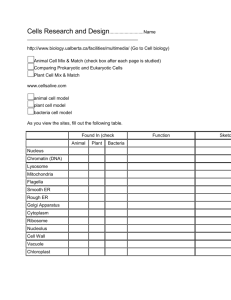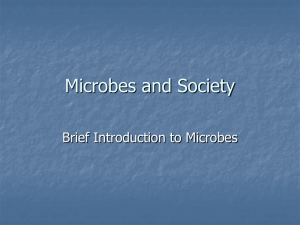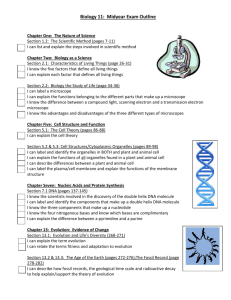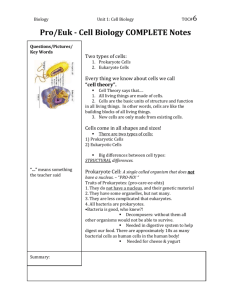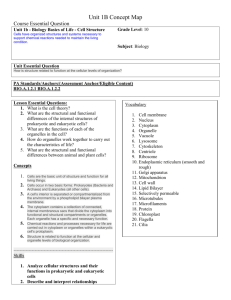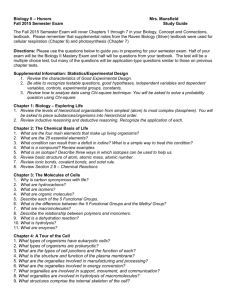Laboratory 5: Cell Structure
advertisement
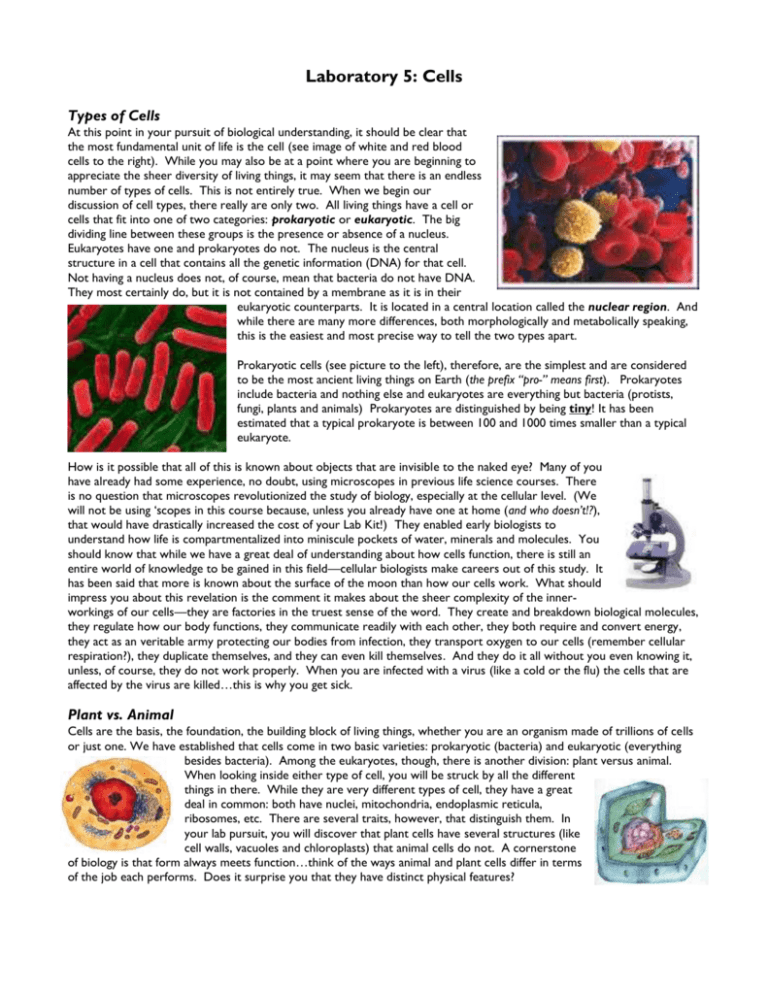
Laboratory 5: Cells Types of Cells At this point in your pursuit of biological understanding, it should be clear that the most fundamental unit of life is the cell (see image of white and red blood cells to the right). While you may also be at a point where you are beginning to appreciate the sheer diversity of living things, it may seem that there is an endless number of types of cells. This is not entirely true. When we begin our discussion of cell types, there really are only two. All living things have a cell or cells that fit into one of two categories: prokaryotic or eukaryotic. The big dividing line between these groups is the presence or absence of a nucleus. Eukaryotes have one and prokaryotes do not. The nucleus is the central structure in a cell that contains all the genetic information (DNA) for that cell. Not having a nucleus does not, of course, mean that bacteria do not have DNA. They most certainly do, but it is not contained by a membrane as it is in their eukaryotic counterparts. It is located in a central location called the nuclear region. And while there are many more differences, both morphologically and metabolically speaking, this is the easiest and most precise way to tell the two types apart. Prokaryotic cells (see picture to the left), therefore, are the simplest and are considered to be the most ancient living things on Earth (the prefix “pro-” means first). Prokaryotes include bacteria and nothing else and eukaryotes are everything but bacteria (protists, fungi, plants and animals) Prokaryotes are distinguished by being tiny! It has been estimated that a typical prokaryote is between 100 and 1000 times smaller than a typical eukaryote. How is it possible that all of this is known about objects that are invisible to the naked eye? Many of you have already had some experience, no doubt, using microscopes in previous life science courses. There is no question that microscopes revolutionized the study of biology, especially at the cellular level. (We will not be using ‘scopes in this course because, unless you already have one at home (and who doesn’t!?), that would have drastically increased the cost of your Lab Kit!) They enabled early biologists to understand how life is compartmentalized into miniscule pockets of water, minerals and molecules. You should know that while we have a great deal of understanding about how cells function, there is still an entire world of knowledge to be gained in this field—cellular biologists make careers out of this study. It has been said that more is known about the surface of the moon than how our cells work. What should impress you about this revelation is the comment it makes about the sheer complexity of the innerworkings of our cells—they are factories in the truest sense of the word. They create and breakdown biological molecules, they regulate how our body functions, they communicate readily with each other, they both require and convert energy, they act as an veritable army protecting our bodies from infection, they transport oxygen to our cells (remember cellular respiration?), they duplicate themselves, and they can even kill themselves. And they do it all without you even knowing it, unless, of course, they do not work properly. When you are infected with a virus (like a cold or the flu) the cells that are affected by the virus are killed…this is why you get sick. Plant vs. Animal Cells are the basis, the foundation, the building block of living things, whether you are an organism made of trillions of cells or just one. We have established that cells come in two basic varieties: prokaryotic (bacteria) and eukaryotic (everything besides bacteria). Among the eukaryotes, though, there is another division: plant versus animal. When looking inside either type of cell, you will be struck by all the different things in there. While they are very different types of cell, they have a great deal in common: both have nuclei, mitochondria, endoplasmic reticula, ribosomes, etc. There are several traits, however, that distinguish them. In your lab pursuit, you will discover that plant cells have several structures (like cell walls, vacuoles and chloroplasts) that animal cells do not. A cornerstone of biology is that form always meets function…think of the ways animal and plant cells differ in terms of the job each performs. Does it surprise you that they have distinct physical features? Procedure This lab is considered a “dry” lab because you will not be performing any experiments…instead, you will be visiting several websites and following the directions to experience all there is to offer there. Be sure you follow the directions initially as there is a lot to explore on these sites. Feel free to use the sites as a resource, in preparation for you exam; peruse them as you wish once you are done with your lab…be careful, you might learn something!! Part 1—Estimate Size of Cells, Viruses and Other Things 1. 2. 3. 4. 5. 6. Visit www.cellsalive.com . Click on “Cell Biology” on the left side of the page. Click on “How big is a…” and allow the animation to load. You should see an image of fingers holding a pin. Click on the purple arrows under the picture to the right of the word “Magnification”. You will see the image become more and more magnified the more you click. Notice the scale change at the bottom of the picture. Along the right side of the picture, there is a list of items (i.e. “human hair”, “dust mite”, “ragweed pollen”). These are the items that you will see magnified. To see what an Ebola virus looks like, point the cursor to the word “Ebola virus” to see the picture in the box above the list. Using the ruler in the box, estimate the size of some of these and record on the Answer Sheet: a. Dust mite b. Lymphocyte c. E.coli d. Baker’s Yeast (same thing you used in Lab 4!) e. Rhinovirus (the virus that causes colds!) Part 2—Compare and Contrast Animal, Plant and Bacterial Cells 1. From the site above, click back on the “Cell Biology” link along the left side of the page. 2. Click on “Cell Models”. 3. Click on “Plant Cell” and read about all of the organelles. Answer the following questions on your answer sheet: a. What is the role of a vacuole in a plant cell? What color is it in this diagram? (You can identify parts of the cells by running your mouse over different structures. The names appear in the box above the list of organelles. The names of the organelles are links to definitions.) b. What are cell walls made of in plants and what is their function? c. Why are chloroplasts green? 4. Click on “Animal Cell” at the top of the page. Read about all of organelles. Answer the following questions on your answer sheet: a. What do lysosomes do? b. What is the purple structure in the center of the cell? What is its function? c. What is the orange colored structure? Do plants have this structure? Do bacteria? 5. 5. Click on “Bacterial Cell” at the top of the page. Answer the following questions on your answer sheet: a. What are the small, red structures that protrude from the sides of the cell in this diagram? What is their function? b. What is the difference between pili (sing pilus) and flagella (sing flagellum)? Part 3—Bacterial Growth 1. On the same site (www.cellsalive.com) click on “Cell Cams” on the left side. Click on “Bacteria Cam” 2. If you are completing the lab at midnight, 6 am, noon, or 6 pm, there will be little to see and you should check back later to give the population time to grow as this is an actual picture of a bacterial population increasing in size over time. The left box shows the initial population (2 cells) and the right box shows the current population. If the current population is large, you can click on the intermediate box (center) “-1”, “-5” or “-20” to see the population get smaller from the current population or “+1”, “ +5”, or “+20” to see it increase from the initial population. You will be moving the time frame by 1, 5, or 20 minute increments. Try to estimate the growth rate of the population by counting the increase (new population –original population) over time. Enter this estimation on your Answer Sheet. Here is another great website for reviewing Cell Biology: http://www.bbc.co.uk/education/asguru/biology/01cellbiology/index.shtml
